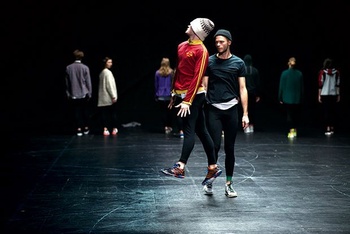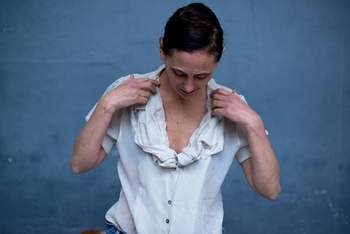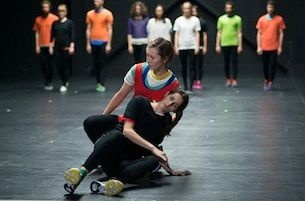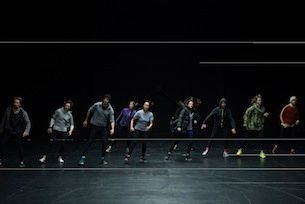(© Anne Van Aerschot)
In March, Anne Teresa De Keersmaeker will transpose her Vortex Temporum choreography to the exhibition space of the WIELS Contemporary Art Centre; February will see her dancing again, in Fase, as the Beursschouwburg celebrates its birthday. This month, however, her new Rosas work, Golden Hours, will be premiered at the Kaaitheater – with the enthusiastic collaboration of William Shakespeare and Brian Eno.
In her last large-scale group production, Vortex Temporum, De Keersmaeker presented time as Gérard Grisey made it whirl in his complex music. Her latest choreography, for eleven dancers, Golden Hours, also looks at the passage of time, but in a different way and using different resources. Her return to pop music, some five years after her dialogue with the Beatles in The Song, sees De Keersmaeker hanging out with Brian Eno. “Over the last few years, I have become more rigorous in my choice of music,” says the Brussels choreographer. “I find myself attracted to pre-baroque music, Bach, the modern classical music of – for example – Webern, and certain contemporary composers. Pop music is the music we are most connected with today. We can maybe still whistle a little Bach and Beethoven, but the rest is pop music. The presence of a beat means that pop music is also related to dance, and as there are also lyrics involved, you have storytelling too. Pop music has always been part of my daily life and part of my dance life. For certain choreographies, for example, I came up with movements to pop music that I took away again later in the process.”
What is your connection with Brian Eno’s music and with this piece in particular?
Anne Teresa De Keersmaeker: In the early days of Rosas, Thierry De Mey was my most important musical dealer. He introduced me to Roxy Music, to a lot of Talking Heads – for me, Remain in Light, to which Eno made a major contribution, is still one of the best pop albums ever made – and to Eno’s solo work. Eno had a special status in the music world. He was the sound wizard, constantly shifting between very articulate intellectual thoughts and the anarchistic and nonsensical, between the female and male, between the extremely concrete and the extremely spacy.
Anne Teresa De Keersmaeker: life with Brian


(© Anne Van Aerschot)
When I made The Song, I couldn’t make up my mind for a long time between the Beatles’ White Album and this piece. I started listening intensively to Eno’s music again then. Another Green World is a key record for Eno, because he made it after he left Roxy Music but before his ambient period. And I fell in love with the song “Golden Hours”. It has a certain melancholy and deals with the passage and even the reversibility of time. I think there is a beautiful elegance in the text, which has a zest but is not closed or heavy. It is full of secrets, open to questions, and always in suspension.
I met Eno a few times. We were both mentors for the Rolex Foundation and we also met at the award ceremony of honorary doctorates at the UCL, where we spent a fair amount of time together. Later, he came to see a few shows in London and I also visited his studio a few times.
Are there similarities in the way you both work? Eno, too, keeps on indefatigably trying out new things, unravelling them, and analysing them.
De Keersmaeker: I don’t know what our common ground is, but what I like about him is that on the one hand he has a very strong intuition and undefined way of working and on the other likes methods and structures. He has a nearly Eastern, Taoist attitude to whatever happens and at the same time this slow pace of searching and trying things out, step by step. In the studio he often spends time tinkering and trying stuff out. You can feel, too, that he has come from the visual arts, as he really approaches sounds as concrete material. He is also very much aware of the world and is socially and politically committed. And he has Flemish roots too. His mother is from Dendermonde; she fell in love with a British soldier. At the presentation of the honorary doctorates, he had more family there than I did.
When I made The Song, I couldn’t make up my mind for a long time between the Beatles’ White Album and this piece. I started listening intensively to Eno’s music again then. Another Green World is a key record for Eno, because he made it after he left Roxy Music but before his ambient period. And I fell in love with the song “Golden Hours”. It has a certain melancholy and deals with the passage and even the reversibility of time. I think there is a beautiful elegance in the text, which has a zest but is not closed or heavy. It is full of secrets, open to questions, and always in suspension.
I met Eno a few times. We were both mentors for the Rolex Foundation and we also met at the award ceremony of honorary doctorates at the UCL, where we spent a fair amount of time together. Later, he came to see a few shows in London and I also visited his studio a few times.
Are there similarities in the way you both work? Eno, too, keeps on indefatigably trying out new things, unravelling them, and analysing them.
De Keersmaeker: I don’t know what our common ground is, but what I like about him is that on the one hand he has a very strong intuition and undefined way of working and on the other likes methods and structures. He has a nearly Eastern, Taoist attitude to whatever happens and at the same time this slow pace of searching and trying things out, step by step. In the studio he often spends time tinkering and trying stuff out. You can feel, too, that he has come from the visual arts, as he really approaches sounds as concrete material. He is also very much aware of the world and is socially and politically committed. And he has Flemish roots too. His mother is from Dendermonde; she fell in love with a British soldier. At the presentation of the honorary doctorates, he had more family there than I did.


(© Anne Van Aerschot)
Shakespeare was an inspiration too. We understand that you often implicitly make use of a play to help create a structure. As with As You Like It, in this case.
De Keersmaeker: In the recent past, I explored the “step” as the organising logic of movements in space and time – a principle that I call “my walking is my dancing”. Now it is time to explore “speaking” as the socialising logic of relationships between different moving bodies – the principle I refer to as “my talking is my dancing”. The use of a play can help me to develop and structure the “talking”. Recent productions like En Atendant, Cesena, and Partita also had a hidden narrative. Not a complete story, but storylines and characters related to that music’s historical context. Those elements played a part in deciding how the dancers related to each other. So, on the one hand you had the rigorous formal framework that was based on the music and on the other a more dramatic, theatrical, and emotional network of human relationships.
Shakespeare was an inspiration too. We understand that you often implicitly make use of a play to help create a structure. As with As You Like It, in this case.
De Keersmaeker: In the recent past, I explored the “step” as the organising logic of movements in space and time – a principle that I call “my walking is my dancing”. Now it is time to explore “speaking” as the socialising logic of relationships between different moving bodies – the principle I refer to as “my talking is my dancing”. The use of a play can help me to develop and structure the “talking”. Recent productions like En Atendant, Cesena, and Partita also had a hidden narrative. Not a complete story, but storylines and characters related to that music’s historical context. Those elements played a part in deciding how the dancers related to each other. So, on the one hand you had the rigorous formal framework that was based on the music and on the other a more dramatic, theatrical, and emotional network of human relationships.
Now that is even more explicitly the case. In addition to “Golden Hours” from Another Green World, there is a completely different track of As You Like It. Not a royal drama, but a light-footed love comedy, not bereft of melancholy, with two main central themes. First there is the gender theme. The play questions the very nature of the female and the male, in a quite light way. The main character, Rosalind, a strong, bright woman, is one of the most wonderful female characters in Shakespeare. The other theme is that of the opposition between cultivated urban life and the Forest of Arden, which is compared to a golden world where mankind lived in harmony with nature. The play raises questions like “What is artificial and what is natural?”, “Did there exist something like initial harmony with nature?”, “Are we constantly evolving further away from it?”, “Is there something like another, green world?”, and “Do we have to move to another planet like in the movie Interstellar?”
NO MONEY, NO DANCE
The announcement in mid-December that the opera house – as a consequence of budget cutbacks imposed by the new government – found itself forced to scrap all dance productions from its programmes caused uproar in the cultural sector. “I received the news that De Munt/La Monnaie’s management was cancelling all dance productions with incredulity,” reacted Anne Teresa De Keersmaeker, who had not been consulted about the decision. While her fellow choreographer Sidi Larbi Cherkaoui has moved the revival of Babel(words) to Les Halles de Schaerbeek, De Keersmaeker is still trying to achieve a solution with the opera house. “I still very much regret that the solution to the financial problems, which are real, consists in sacrificing dance. For us it is not just about the financial aspect. It is about a major performance space and about the position of dance and of Rosas in Brussels and Belgium. Dance had an important role in De Munt/La Monnaie for fifty years. I really doubt if sacrificing that is the best solution.”
GOLDEN HOURS • 23, 24, 28 > 31/1, 20.30 (+ intro: 20.00, gratis/gratuit/free, EN), 25/1, 15.00, €12,50/20/25, Kaaitheater, square Sainctelettesquare 20, Brussel/Bruxelles, 02-201.59.59, www.kaaitheater.be
NO MONEY, NO DANCE
The announcement in mid-December that the opera house – as a consequence of budget cutbacks imposed by the new government – found itself forced to scrap all dance productions from its programmes caused uproar in the cultural sector. “I received the news that De Munt/La Monnaie’s management was cancelling all dance productions with incredulity,” reacted Anne Teresa De Keersmaeker, who had not been consulted about the decision. While her fellow choreographer Sidi Larbi Cherkaoui has moved the revival of Babel(words) to Les Halles de Schaerbeek, De Keersmaeker is still trying to achieve a solution with the opera house. “I still very much regret that the solution to the financial problems, which are real, consists in sacrificing dance. For us it is not just about the financial aspect. It is about a major performance space and about the position of dance and of Rosas in Brussels and Belgium. Dance had an important role in De Munt/La Monnaie for fifty years. I really doubt if sacrificing that is the best solution.”
GOLDEN HOURS • 23, 24, 28 > 31/1, 20.30 (+ intro: 20.00, gratis/gratuit/free, EN), 25/1, 15.00, €12,50/20/25, Kaaitheater, square Sainctelettesquare 20, Brussel/Bruxelles, 02-201.59.59, www.kaaitheater.be
Read more about: Podium
Fijn dat je wil reageren. Wie reageert, gaat akkoord met onze huisregels. Hoe reageren via Disqus? Een woordje uitleg.